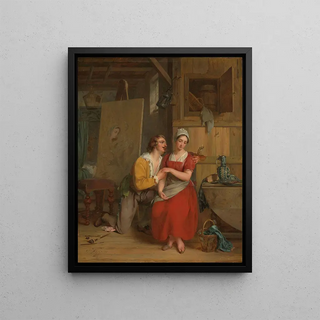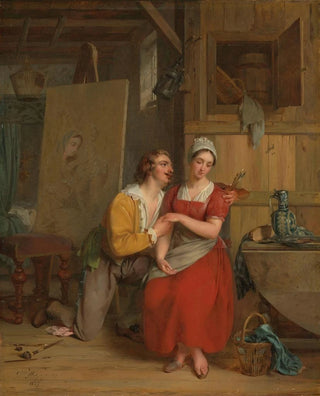Art print | Anthony van Dyck courts his model - Gustaf Wappers


View from behind

Frame (optional)
In the vast panorama of art history, certain works stand out for their ability to capture the very essence of artistic creation. The art print "Anthony van Dyck courtes his model" by Gustaf Wappers is a shining example. This painting, which evokes the encounter between art and beauty, immerses us in a universe where emotion and aesthetics harmoniously intertwine. Through this piece, Wappers pays tribute to one of the most influential Flemish masters of the 17th century, Anthony van Dyck, while infusing his own artistic vision. The depicted scene is not limited to a simple portrait but rises to the level of a true statement on the nature of inspiration and creation.
Style and uniqueness of the work
Wappers' style is characterized by meticulous attention to detail and a rich, nuanced color palette. In this art print, light plays a crucial role, illuminating the faces of the protagonists and creating an intimate, warm atmosphere. The drapery of the clothing, carefully rendered, testifies to the technical mastery of the artist, while the expressions of the characters reveal a fascinating psychological depth. The composition, carefully balanced, guides the viewer's gaze and invites them to delve into the intimacy of this scene. Every element, from the background to the accessories, contributes to creating a visual narrative that transcends time and space, allowing the viewer to feel the palpable tension between the painter and his model.
The artist and his influence
Gustaf Wappers, born in 1803, was a Belgian painter whose work is rooted in the Romantic movement. His fascination with the great masters of Flemish painting, particularly Anthony van Dyck, is evident in his desire to revisit classical themes while bringing his own sensitivity to them. Wappers successfully integrated elements of his era, while paying homage to tradition, which allowed him to forge a unique artistic identity. His work serves as a bridge between the past and the present, a celebration of aesthetic values that have shaped European art. By choosing to depict Van Dyck, Wappers highlights

Matte finish

View from behind

Frame (optional)
In the vast panorama of art history, certain works stand out for their ability to capture the very essence of artistic creation. The art print "Anthony van Dyck courtes his model" by Gustaf Wappers is a shining example. This painting, which evokes the encounter between art and beauty, immerses us in a universe where emotion and aesthetics harmoniously intertwine. Through this piece, Wappers pays tribute to one of the most influential Flemish masters of the 17th century, Anthony van Dyck, while infusing his own artistic vision. The depicted scene is not limited to a simple portrait but rises to the level of a true statement on the nature of inspiration and creation.
Style and uniqueness of the work
Wappers' style is characterized by meticulous attention to detail and a rich, nuanced color palette. In this art print, light plays a crucial role, illuminating the faces of the protagonists and creating an intimate, warm atmosphere. The drapery of the clothing, carefully rendered, testifies to the technical mastery of the artist, while the expressions of the characters reveal a fascinating psychological depth. The composition, carefully balanced, guides the viewer's gaze and invites them to delve into the intimacy of this scene. Every element, from the background to the accessories, contributes to creating a visual narrative that transcends time and space, allowing the viewer to feel the palpable tension between the painter and his model.
The artist and his influence
Gustaf Wappers, born in 1803, was a Belgian painter whose work is rooted in the Romantic movement. His fascination with the great masters of Flemish painting, particularly Anthony van Dyck, is evident in his desire to revisit classical themes while bringing his own sensitivity to them. Wappers successfully integrated elements of his era, while paying homage to tradition, which allowed him to forge a unique artistic identity. His work serves as a bridge between the past and the present, a celebration of aesthetic values that have shaped European art. By choosing to depict Van Dyck, Wappers highlights






